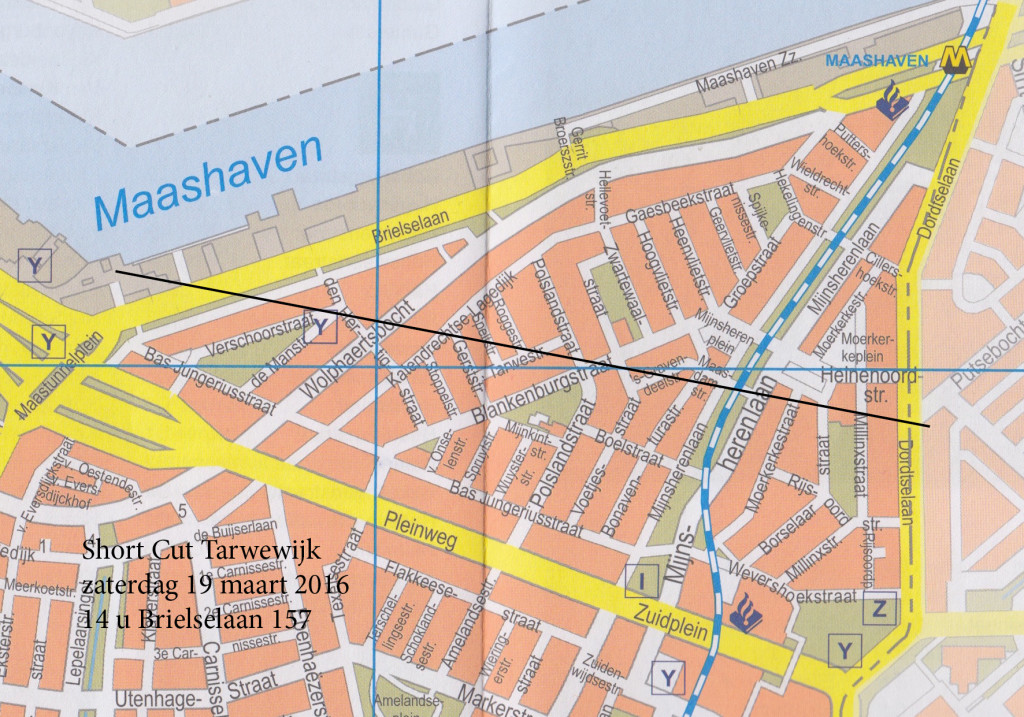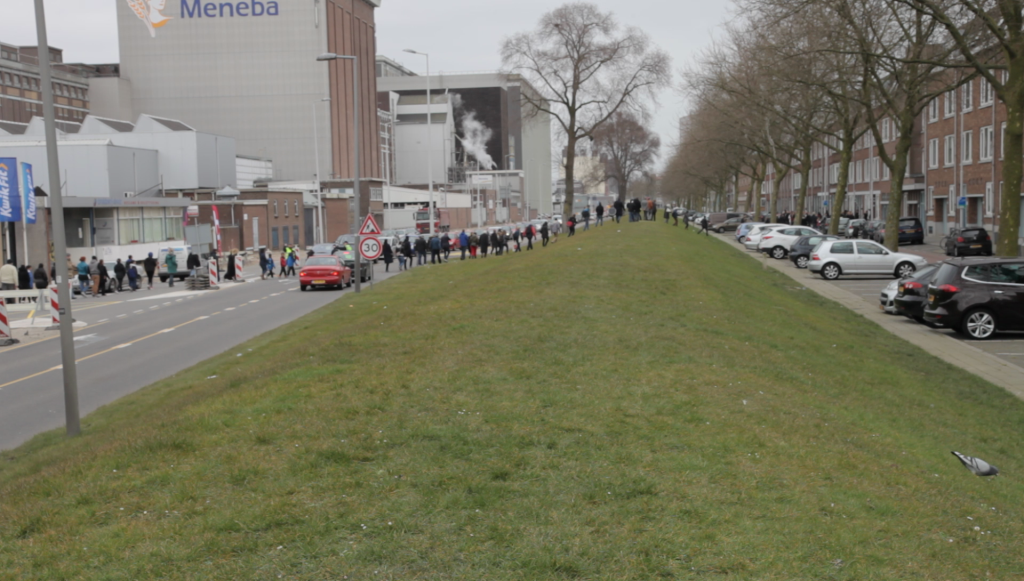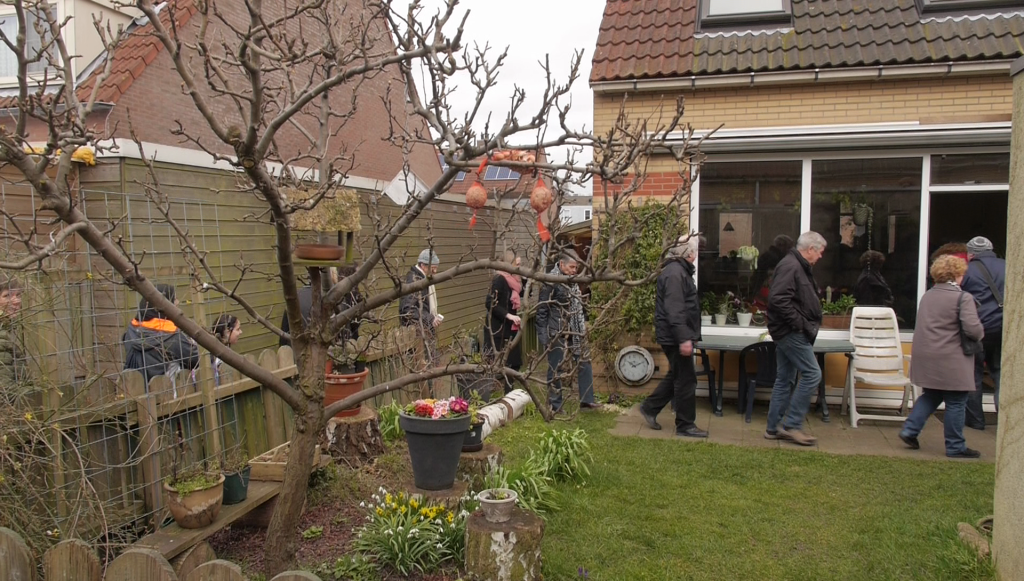Short Cut Tarwewijk
On March 19, 2016, 200 people hiked along one straight long line directly through the open spaces and private yards of the Tarwewijk (Rotterdam). The group went through front doors and out backdoors into the neighbours yard on the following street. The continuous line included schools, churches, homes and gardens that were randomly selected. It crossed not only the picturesque places but also the architectural highlights, historical buildings, average homes, and forgotten corners. The line crossed seamlessly from one location into the next.
There were negotiations with each resident or owner of a location so that the line would flow without interruption. An important motive for the promenade was to create an experience of seeing a familiar urban environment from another perspective. Short Cut Tarwewijk is a poetic mechanism that sets the scene for equality and breaks apart hierarchies: equality because everyone is engaged in the same activity (in a line); power structures that fall apart because people see their surroundings in a different way.
As a result, the hike could create a reflection about the basic idea that a city is just a collection of properties and structures. ‘Maybe they will shed a new light on the lost, utopian idea of shared spaces or the communal.’
(Film/ Full HD: 30′:00”)








Thank you for your contribution, Stijn. It makes a great case for reflecting on how to reclaim public and common spaces in the city through simple actions. I find the idea of the ‘straight line’ very fascinating, as much as problematic: it represents, as you suggest, equality at its best, but I am afraid that in an attempt to ‘equalize’ the urban landscape we loose sensibility for the conflicts, the differences, the tensions, etc. Is there a way in which the ‘participatory’ nature of the walk won’t hinder the possibility of visibilising the tensions specific to the spaces that it passes through? How can you make the negotiations with local residents central part of such a project, rather than the result (being able to pass through ‘without interruption’)?
Dear Pablo,
thank you for your appropriate remark. To answer this I first have to make a distinction between two different shapes of the work: the performance (and preparation of the walk) and the document(s)/ film(s) which are meant to be seen in a gallery/ museum. This distinction is important in the context of one of the main subjects of my practice, which I would describe as a constantly reflective search for the art space and its meaning in todays problematic capitalistic/ neoliberal context.
Organizing the walk is much more then the concept (which isn’t maybe really that interesting on itself I think). Details were very important, the fact for example that I lived for almost three months in that specific neighborhood, that I frequent many local organizations, that I helped as a volunteer during an annual feast ect.. It was a really heavy task to succeed and I don’t have to tell you that there were also many negative reactions which were equally meaningful as the positive ones. Important seems to be that the idea started to live in the neighborhood and that this rather senseless action was part of debate and discussions. I can assure you that tensions and conflicts were part of the game and thus intensified differences in the neighborhood rather than equalize everything. In a certain sense in this phase it is an artistic idea that comes as ‘a jammer’ into the daily life and of course that is as much part of the work as the very ‘positive’ / collective/ ‘festive’ experience of the walk.
Bringing this experience into the artspace endeed causes many questions. It asks for a translation which has to do with installing a new distance. My initial plan was to work with two layers in which two elements were equally important. I wanted to capture the walk (while the city was approached as a kind of map/ 24 cameraviews registered the trip), and I wanted to use the stories/ conversations ect. I collected during my working period (often very normative ideas and visions). The idea was to confront the walk with a kind of latent, mental architecture that is not really visible, but nevertheless structured social life in an important way. Starting the montage, I decided very soon to quit the second layer because the film lost to much of its potential quality (it’s much more related to Kafka than to … Jeanne Van Heeswijck e.g I guess). Anyway I didn’t give up to make an additional/ confronting document with the stories (which I’m working on at the moment). Although the direction it goes seems to be much more art reflective than society reflective … The idea is to confront these two documents in an exhibition context.
Not sure if that is a proper answer to your question/ in anyway the supporting text I added on the web page doesn’t really suffice…
Fascinating project, Stijn. While it resonates with a lot of the situationists, it brings me back to earlier iterations, particularly Alfred Watkins mad ramblings on ley lines–the mysterious occult connections between different physical locations. By envisioning physical geometries of significance, it brought forth discussions on not only use-value and social-cultural meaning but also intrinsic values that are part of our geological world. A straight line is both abstract and very real. Do you see a value in repeating this again in the same location, in the sense of ritual making?
he Michael, thanks for the link to Alfred Watkins, quiet interesting.
Another peace in public space I’m working on at the moment, is based on the idea of a participative annual ritual gesture (action), in stead of making a kind of fixed sculpture. In the case of short cut Tarwewijk, some people of the neighborhood asked me about it, about making an annual event of it. Although it sounds very appealing for me, I also still doubt about the idea. Won’t it become a shadow of the first edition? It needs a lots of energy … but possibly… The question is how to realize this, probably together with a small group of engaged residents who carry out the idea…
A shadow of the initial or perhaps an etching of that original, digging the line a bit deeper each time. It makes me think of the German proverb, Einmal ist keinmal (once is never), which Milan Kundera plays on in his Unbearable Lightness of Being. Perhaps only through ritual does this shortcut become something more than a gesture. Should the ritual be local or global (inviting outsiders)? Should it be you who plays the role of choreographer or local officials or perhaps supra-local actors? I look forward to following this work in the coming years.